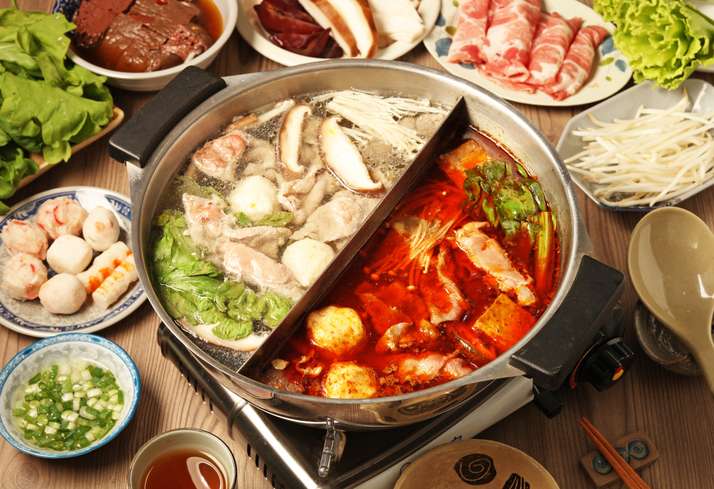
In China, there’s a saying: “There’s no problem a good hot pot can’t fix. And if there is—have another one!” For me, that couldn’t be more true. The boiling broth brings back memories of childhood evenings spent gathered around the pot with family and friends, laughing as the steam fogged up our glasses.
Before we dig into Tokyo’s best hot pot spots, let’s take a quick look at how this comforting dish came to be—because food always tastes better when you know its story.
Why Hot Pot?
In Chinese culture, hot pot is the ultimate communal meal. It’s completely free of coercion; everyone is free to pick out their favorite foods from the steaming soup, creating a meal that’s both shared and personal. The rhythm of it—the waiting, the dipping, the eating—naturally sparks conversation. It’s a connection through food, in its simplest and most joyful form.
The Origins of Hot Pot: A Warming Tradition That Spans Dynasties
The earliest form of hot pot in China dates back over 3,000 years to the Shang and Zhou dynasties. At that time, people used a bronze vessel called a ding (鼎)—an object that served both as a ceremonial tool and a cooking pot. People boiled various ingredients together and ate them directly from the pot. It was, in many ways, the earliest prototype of the modern Chinese hot pot.
Ancient bronze Chinese ding with legs, cooking vessel (credit by rigamondis)
But ding were heavy and hard to transport, making them practical only for fixed locations. By the Western Zhou dynasty (1046 BC–256 BC), the development of bronze, iron and various types of pottery gave rise to smaller cooking vessels—and with them, the first household versions of hot pot.
Tang to Song: A Shared Warmth Around the Table
By the Tang dynasty (618–907), the dish had evolved into what was called nuan guo, or “warm pot.” The famous poet Bai Juyi once wrote, “See green floating foam aglow on my freshly brewed wine, my little red clay stove is burning, and the flame is shining” (translated by Saiou Kang)—a line that perfectly captures the cozy, communal atmosphere of dining around a small stove.
During the Song dynasty (960–1279), hot pot became popular among the common people. Historical records, such as Dreams of Splendor of the Eastern Capital, describe how winter markets in the capital city offered “warm stoves” for people to enjoy sliced meat dipped in boiling broth—a clear ancestor of the modern hot pot.
Nomadic Influence and the Rise of the “Hot Pot” Name
By the Yuan dynasty (1271–1368), nomadic influences from the north had a major influence on the development of hot pot. Herdsmen would boil thinly sliced meat in metal pots with water or milk—a convenient cooking method well-suited to the cold northern climate.
The term huo guo (火锅), meaning hot pot as we know it today, first appeared during the Qing dynasty (1644–1911), when the dish reached its peak in popularity. It was served both in the imperial court and among ordinary households. In fact, imperial menus from that era often included hot pot as a regular dish. By the late Qing dynasty, the look and style of hot pot were almost identical to what we enjoy today.
Credit: Silver hot pot with longevity pattern, Qing Dynasty, from the collection of the Palace Museum, Beijing
Over time, different regions across China developed their own unique versions—northern lamb hot pot, spicy Sichuan tripe hot pot, Cantonese seafood hot pot and many others—each reflecting local tastes and ingredients. Yet they all share one essential principle: there must be harmony between the soup base and the ingredients. For example, spicy hot pot pairs perfectly with tripe and duck intestines, while dregs vinegar broth complements seafood. Each soup base brings its own ideal combinations, creating endless possibilities for taste and texture.
Three Classic Styles of Hot Pot
Spicy Sichuan Tripe Hot Pot:
If there’s one phrase that defines Sichuan and Chongqing hot pot, it’s “no spice, no happiness.” As you can probably tell from the picture, Sichuan hotpot is famous for its fiery red broth. Chili peppers and Sichuan peppercorns create that signature: numbing heat and rich, oily flavor. The ingredients are just as varied as the flavors, ranging from meats and seafood to vegetables and soy products. The city of Chongqing has even been named the “Hotpot Capital of China” by the China Cuisine Association—a well-deserved title for this beloved culinary icon.
Northern Lamb Hotpot:
As a northerner, the copper hotpot is the most familiar to me. Its metal body conducts heat quickly and evenly, preserving the tenderness of the meat.
Another hallmark of traditional Beijing copper pot hot pot is the clear water broth that absorbs the fat from the mutton, creating a clean yet flavorful soup. Lamb is the star here, along with beef and tripe. Side dishes include vermicelli, suan cai (pickled Chinese cabbage) and frozen tofu, and the portions are generally substantial.
Cantonese Seafood Hot Pot:
Down south, the Guangdong-style hot pot takes a lighter, ocean-inspired approach. Think fresh shrimp, plump clams and all kinds of seafood in in a clear, aromatic broth. Springy meatballs—especially the famous Chaoshan beef balls—are also a local favorite. The selection of vegetables is more diverse as well, including southern specialties like bamboo fungus and termite mushrooms, giving the meal a distinctly southern character.
Hot Pot’s Journey From China to Japan
It’s hard to draw a single line between Chinese hot pot and Japan’s many versions of it. Still, the idea of gathering around a simmering communal pot traveled naturally across East Asia through trade, migration and everyday exchange.
In Japan, this idea took root as nabemono (鍋物), meaning “things in a pot.” By the Edo period (1603–1868), small one-pot meals like konabe (小鍋) became common in restaurants and homes. These early hot pot dishes reflected the same social warmth as their Chinese counterparts but were already adapting to Japan’s ingredients and cooking styles.
The story of shabu-shabu shows this exchange best. In the 1940s, Dr. Shoya Yoshida, a Japanese army surgeon from Tottori, discovered shuan yang rou (涮羊肉), a Mongolian-style “instant-boiled mutton” dish, while stationed in Beijing. Captivated by its simplicity—thin slices of meat swished in hot broth and dipped in sauce—he brought the idea back to Japan after the war. Working with a Kyoto restaurant, he replaced mutton with the more familiar beef, swapped heavy broths for kelp-based dashi, and refined the sauces to suit Japanese tastes. The result was shabu-shabu, a lighter cousin of Chinese hot pot that quickly became a nationwide favorite.
Credit by Artit_Wongpradu
Rather than a simple adoption of Chinese hot pot, Japan’s hot pot style evolved via adaptation: it incorporated local ingredients, lighter broths and sometimes distinct cooking vessels (such as the Japanese donabe earthenware pot).
Today, Japanese hot-pot styles and Chinese hot-pot traditions continue to influence each other, particularly in international cities such as Tokyo, though each culture retains its own distinct flavor and social rituals.
If you’d like to explore more of Tokyo’s authentic Chinese dining scene beyond hot pot, check out our feature Where to Eat Authentic Chinese Cuisine in Tokyo for a curated guide to standout restaurants.
Best Chinese Hot Pot Restaurants in Tokyo
Zakuro Ginza
Featured in Satomi Ishihara’s hit drama “Unnatural,” Zakuro Ginza sits near Mitsukoshi Department Store and Matsuya. The restaurant serves both shabu shabu and traditional copper hot pot, along with several set menus.
4−6−1 Ginza Sanwa Bldg, B1, Ginza, Chuo-ku
zakuro.co.jp/restaurant/ginza
Toraijun Ikebukuroten
Decorated in old Beijing style, Toraijun offers one of the most authentic northern copper pot hot pot experiences in Tokyo.
1−23−1 El Cruce, 6F, Nishiikebukuro, Toshima-ku
ggtm600.gorp.jp
三様菜(さんようさい)Sanyosai Hot Pot
Photo from Sanyosai Official Website
Photo from Sanyosai Official Website
Known for its classic Chongqing two-color hot pot, Sanyosai offers a choice between a fragrant, spicy soup and a mild one. Spiciness levels range from mild to extra spicy, so if you’re trying Chongqing hotpot for the first time, start with the lowest setting (Lunch hot pot sets are also available).
D: Vort Ikebukuro, 6F, 1−38−3, Nishiikebukuro,Toshima-ku
hinabesupernumberone.owst.jp
Ura no Yama no Kinoko Shibuya (Mushroom Hot Pot)
A heaven for mushroom lovers, this spot specializes in earthy mushrooms hot pot. The broth is rich and aromatic, with condiments like Chinese fermented bean chili sauce and Zhenjiang vinegar available at the counter.
1−3−11 Ichiban Bldg., 2F, Dogenzaka, Shibuya-ku
lit.link/en/uranoyamanokinokojp
10-Zen Yakuzen Restaurant
Photo from 10-Zen Yakuzen Official Website
For a healthy twist, this hidden gem combines hot pot with traditional herbal medicine. Run by a company with roots in herbal medicine, this place takes the idea of “food as healing” seriously.
5-10-19 Aoyama Shinyo Building, B1, Minamiaoyama, Minato-ku
10-zen.com/aoyama
How To Make the Best Dipping Sauce
The authentic flavor of Chongqing hot pot can be summed up in three words: fragrant, spicy and garlicky. The dipping sauce, known as “oil dipping,” is essential. Pour a generous amount of sesame oil into the bowl, add a tablespoon of minced garlic, chopped cilantro (skip it if you’re not a fan) and chopped green onions. Finish with a few drops of soy sauce for extra depth of flavor.
When it comes to the copper hot pot, the dipping sauce is equally crucial. The traditional Beijing-style sauce is made by blending sesame paste, fermented bean curd, chives, soy sauce, sesame oil and other seasonings. This rich, nutty dip pairs perfectly with thinly sliced lamb. In Tokyo, you can substitute sesame paste with nerigoma (練りごま), which has a slightly lighter but smoother flavor.
As autumn deepens, there’s nothing like a steaming hotpot to warm you from the inside out. Picture this: the pot bubbling with red oil, slices of beef changing color in the broth, tripe simmering and a handful of crisp greens just added. The steam rises, curling like white mist, and for a moment, all worries melt away. It’s the most heartwarming—and healing—moment of the colder months.





